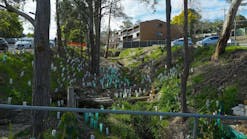Augusta, GA Stormwater Basin Rehabilitation
This location lacked a consistent stormwater maintenance plan, leaving the property to fall out of compliance. In mid-2019, a small cleanup occurred after a neighbor of the property claimed their dog had been bitten by a rattlesnake that had come from the basin. The incident prompted underbrush removal of the stormwater asset to clear any hiding spots for possible snakes, but the client did not enable a long-term maintenance plan. After this minor removal of underbrush and woody vegetation, the area went unmaintained for another 1.5 years.
In August of 2020, this store received a Notice of Violation (NOV) by the county Mosquito Control Department for overgrown vegetation and trash collection within their stormwater detention basin. The site had not been adequately maintained for a few years, allowing vegetation and plants to grow uncontrollably. Excessive nuisance growth and lack of maintenance caused considerable damages to the system. The fence was in disarray, covered in vining plants, and in some areas had collapsed entirely due to lack of vegetation control. The extra vegetation acted as a net that collected excessive trash and debris within the basin and provided the perfect mosquitoes’ perfect environment to thrive. The inlets and outlet control structure (OCS) were covered in plant stems and roots, with excessive sedimentation at the mouths.
AQUALIS specialists met on-site with County Mosquito Control to determine which areas needed repair. Overgrown woody vegetation was cut and removed from along the fence line and within the basin. This vegetation had to be removed because it was not part of the original site plan. Unplanned vegetation growth can disrupt the water levels, impact inspection site lines, and can result in damage to the slopes and structural components as well as promote the presence of pests in the form of Nutria or muskrat. Once the vegetation was in control, trash, and debris that was collected in the vegetation was removed. The OCS required vegetation and sediment to be cleared from the low flow orifice to allow flow and restoring functionality, preventing further significant damage to the system, including flooding. During the stormwater rehabilitation, it was discovered that stone cofferdams and silt filter rings were preventing discharge and were removed. The two inlets within this basin required vegetation and sediment removal similar to the OCS to protect the structures and restore flow rates. Lastly, once the basin was within regulatory requirements and future damage risks were minimized, the fence was repaired.
This NOV and rehabilitation could have been avoided through proper stormwater maintenance programs. Contact AQUALIS to learn how our stormwater management solutions can help property owners avoid hefty NOV fines through stormwater maintenance.
Editor's Note: Scranton Gillette Communications and the SGC Water Group are not liable for the accuracy, efficacy and validity of the claims made in this piece. The views expressed in this content do not reflect the position of the editorial teams of Water & Wastes Digest, Water Quality Products and Storm Water Solutions.






